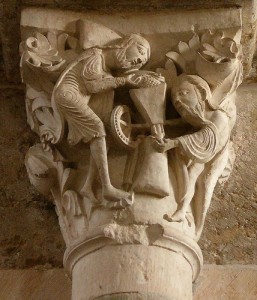The mystic mill is damned in Celan’s Spät und tief:
….
Sie rufen: Ihr lästert!Wir wissen es längst.
Wir wissen es längst, doch was tuts?
Ihr mahlt in den Mühlen des Todes der weiße Mehl der Verheißung,
ihr setzet es vor unsern Brüdern und Schwestern—Wir schwenken das Weißhaar der Zeit.
Ihr mahnt uns: Ihr lästert!
Wir wissen es wohl,
es komme die Schuld über uns.
….
Es komme ein Mensch aus dem Grabe.
Translation from Felstiner’s Selected poems and prose of Paul Celan (New York: Norton, 2001), page 27:
They cry: Blasphemy!
We’ve known it long since.
Known it long since, but who cares?
You grind in the mills of death the white meal of the Promise,
you set it before our brothers and sisters—We flourish the white hair of time.
You warn us: Blasphemy!
We know it full well,
let the guilt come on us.
….
Let a man come forth from the grave.
It seems to me that similarly the hyphenated Meermühle in Celan’s Le menhir, found in a record under the title Le menhir de St-Renan (last version from 4 August 1961, acc. to JP Lefebvre in his Paul Celan. Choix de poèmes réunis par l’auteur [Paris: Gallimard, 1998], page 352), are not simply about moulins de la mer/mère and moulins de la mort, but also about the mystic mill which grinds the torah, its letters, its bearers, and makes this white dust, both flour and Abel-like smoke or ashes.
Le menhir
Wachsendes
SteingrauGraugestalt, augen-
loser du, Steinblick, mit dem uns
die Erde hervortrat, menschlich,
auf Dunkel-, auf Weißheidewegen,
abends, vor
dir, Himmelsschlucht.Verkebstes, hierhergekarrt, sank
über den Herzrücken weg. Meer-
mühle mahlte.Hellflüglig hingst du, früh,
zwischen Ginster und Stein,
kleine Phaläne.Schwarz, phylakterien-
farben, so wart ihr,
ihr mit-
betenden Schoten.
The Phaläne, great night butterfly (Nachfalter), in French sounds like the tefillin, the prayer boxes, pods (Schoten) or boxes whose Greek name (phylactères in French) evokes classes of butterflies.
Above, the mystic mill at the root of the milling images: Moses and Paul sweating at the mill. Two people working together, Moses feeding the torah into the grinding christic mill, and Paul (in the light projected by the Vézelay windows, rather than the permanent shadow the Moses figure inhabits, not to forget) collecting the flour, and both one could think naïvely interchangeable in history, as anyone who has participated in a harvest knows. Same image in Suger’s St Denis window apparently. In passing: I don’t understand the commentaries equating mill and Christ without further ado. The wheel is cruciform, fine. But isn’t the heart of it, as Faulkner said, the grinding, the minute clicking of time’s little wheels? Jesus here was not the mill but the grain submitting to the spinning stones of history, with no bitterness but sweet flour flowing out, packed and taken to the baker.
Reading Celan has broken the mill.

